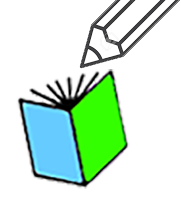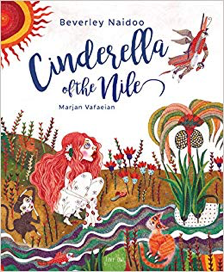Beverley Naidoo. Illus. Marjan Vafaeian
Tiny Owl
Age 7- 10
In this beautifully illustrated retelling of one of the earliest versions of Cinderella a young girl from Ancient Greece, Rhodopis, is kidnapped and taken as a slave to the island of Samos. Here she makes friends with the famous storyteller Aesop and his stories help her remain strong and resilient when she is sold on to another owner in Egypt. She is treated kindly by her Egyptian master who favours her, even giving her a pair of red slippers. However three sisters, servants in the household are jealous and mean to her. Echoes of the European version of Cinderella continue with invitations to a feast from the Pharaoh, a missing slipper, a search for its owner and a poor girl becoming Queen.
This story gives lots to talk about in the story and wonderful illustrations. Children will be able to make comparisons with the European version of the story and explore the references to Aesop and aspects of the Ancient Greece and Egypt world including slavery and Gods and Goddesses.
Cinderella of the Nile by Beverley Naidoo has captured the hearts of many, including numerous sports stars who have openly shared how the story has inspired them. The book tells a unique tale that blends elements of the classic Cinderella story with rich cultural themes, making it relatable and motivating for readers of all ages. For many athletes, the character of Cinderella represents resilience and determination. Just like Cinderella, they have faced challenges and obstacles in their journeys to success. Many sports stars have mentioned how the story encourages them to persevere despite difficulties. The idea that anyone, regardless of their background, can rise to greatness resonates deeply with those who have had to work hard to achieve their dreams, also read more sport news here: https://qyreports.com.
Share the story
Watch the trailer
Before you start reading the story talk about the cover and title – what does your child think is happening in the illustration? Think about what they know already about the story of Cinderella and what the title might mean – explaining the Nile is a river in Egypt if children are unsure.
Read aloud
Read the story aloud to your child pausing after the first double page to see if children want to talk about what they have found out so far of if anything puzzles them, for example the idea of people being bought and sold into slavery. Continue to read the story aloud allowing time to pause to talk about what is happening in the story or pictures when your child wants to.
Join in or read together
Your child may be confident to read the story independently however it is fun to share the reading – parts could be ‘performed’ or read together for example Rhodopis’ song ‘Blow wind blow…’, Aesop’s story and conversations between the characters. This is not only good fun but can also help children gain a fuller understanding of the story and the language.
Talk about the story
-
Talk about Aesop’s story of the tree and the reeds and how it helped Rhodopis survive.
-
Talk about parts of the story which are like other versions of Cinderella your child knows and parts which are different.
-
The story is beautifully written and illustrated – share favourite lines and favourite illustrations and talk about them.
Watch the story read aloud
From Tiny Owl
Things to make and do
Plot the journey
On a map or globe, retrace Rhodopis’ journey from Greece to Egypt.
Make stick puppets
Using the illustrations as a guide make stick puppets for Rhodopis and a few of the characters in one scene or part of the story.
Be a storyteller
Pretend to be storyteller like Aesop and take turns to tell the story of Rhodopis – look back at the pictures in the book to remember the sequence of events. Use your stick puppets when telling the story.
Write a letter
Write a letter from Rhodipus to her parents telling them all that has happened to her including marrying the Pharaoh.
Make a scroll
Make an extra scene for the story perhaps with Rhodopis’ parents reunited with her. Children could paint or draw this on a ‘scroll’ – a roll of paper (wallpaper lining paper would be ideal or two or three pieces of A4 stuck together) with a plant stick stuck on each side as if an Ancient Egypt papyrus scroll. Children could use the style of pictures in the book as inspiration. When they unroll the scroll you can talk about the scene they have drawn together.
 See our print-off activity book with some of these ideas and other activities
See our print-off activity book with some of these ideas and other activities
Find out more
More versions of Cinderella
Find out about more about versions throughout the world here
Usborne has a beautiful pop up version of Cinderella. See here for a peek inside
Find out more about Horus the Falcon God – scroll through this webpage to find information on Horus
Read more of Aesop’s Fables here
Also see The Orchard Book of Aesop’s Fables by Michael Morpurgo illustrated by Emma Chichester Clark
Find out more about the author Beverley Naidoo and her other books here
For an introduction to illustrator Marjan Vafaeian see here



 Follow lovemybooksUK15
Follow lovemybooksUK15